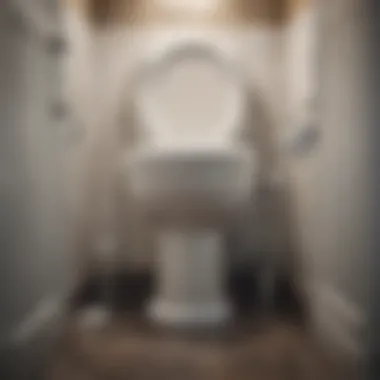Mastering the Toilet Auger: A Homeowner's Guide


Intro
In households, clogged toilets are a common issue. They disrupt daily life and can lead to more serious plumbing problems if not addressed promptly. A toilet auger serves as an essential instrument for resolving these clogs safely and efficiently. This article will take an in-depth look at the key features of toilet augers, the correct way to utilize them, and additional tips for maintaining a healthy plumbing system.
Feature Spotlight
Design Elements of Toilet Augers
Toilet augers are uniquely designed tools that facilitate the clearing of toilet clogs. They consist of a long flexible cable with a specialized head that can break apart blockages. The most notable aspect of a toilet auger is its length, which can be around three to six feet, enabling it to reach the depths of the toilet and even into the drain line.
The handle is usually made from strong materials to support manual rotation. Importantly, toilet augers often come with a protective sleeve that prevents damage to the porcelain of the toilet, a crucial feature that distinguishes them from other plumbing tools.
"Using a toilet auger correctly can extend the lifespan of your plumbing system, making it a powerful tool for home maintenance."
- Unique Features That Matter
- Durability: Toilet augers are built to withstand significant pressure and twisting.
- Flexibility: Their cable can bend and maneuver through pipes, reaching areas that straight pieces cannot.
- Head Design: Various designs are available, including spiral heads that efficiently cut through obstructions.
Understanding these features can help homeowners select the right auger for their specific needs.
Proper Use of a Toilet Auger
Step-by-Step Guide
Using a toilet auger may seem daunting, but following simple steps can make the process manageable. Here’s how to do it:
- Preparation: Start by removing any decorative elements around the toilet to give yourself space to work.
- Insert the Auger: Carefully insert the auger’s head into the toilet bowl, ensuring not to scratch the porcelain.
- Advance the Cable: Gently twist the handle to allow the cable to advance into the drain. Be patient; it might take a few moments to reach the clog.
- Break the Clog: Once resistance is felt, continue turning the handle to break apart or retrieve the clog.
- Remove and Clean: Pull the auger out slowly, ensuring that any debris comes out with it. Clean the tool properly before storing.
Maintenance Tips
- Always clean the auger after each use to prevent bacteria buildup.
- Store it in a dry place to avoid rusting.
By adhering to these steps and maintenance tips, homeowners can have a smoother experience with their plumbing systems.
Foreword to Toilet Augers
Understanding toilet augers is essential for anyone facing plumbing issues, especially with toilets. These tools serve a unique purpose in unclogging toilets that standard plungers might not achieve. Homeowners need a reliable solution to maintain a functioning bathroom. Without proper tools and knowledge, minor clogs can turn into significant problems. This section will lay the foundation for grasping what toilet augers are and how they operate.
Defining a Toilet Auger
A toilet auger is a specialized plumbing tool designed to remove blockages from toilets. Unlike standard plungers that use pressure to clear clogs, toilet augers use a flexible cable to penetrate deeper into the toilet trap. They typically consist of a metal snake attached to a handle, which allows users to manipulate the device with precision. This specificity makes toilet augers effective in dealing with persistent clogs, particularly those caused by hard-to-reach debris or foreign objects.
The Structure of a Toilet Auger
The design of a toilet auger is vital to its effectiveness. Three main components define its structure: the handle design, the flexible cable, and the auger head.
Handle Design
The handle of the toilet auger is crucial for user control. It is usually designed for a firm grip, allowing users to apply the necessary torque without slipping. A good handle design often features ergonomics that reduce fatigue during use. Some augers have a cranking mechanism, which enables better handling while maneuvering the cable inside the toilet. However, not all handles are equal; some may not provide as much comfort or control, potentially leading to user frustration during a clog clearance.
Flexible Cable
The flexible cable is the heart of the toilet auger. This component allows the auger to navigate the twists and curves of the toilet's plumbing. A well-made flexible cable will be robust enough to push through clogs without breaking or bending excessively. Its flexibility is its strength, as it can reach around bends in the pipes that other tools cannot. However, cables that are too flimsy may fail to penetrate tough blockages. Therefore, a balanced cable is critical for the auger's overall effectiveness.
Auger Head
The auger head is the business end of the tool. This component usually has spiral barbs or claws designed specifically for grabbing and breaking apart clogs. The unique shape of the auger head is vital for its ability to latch onto debris and pull it free from the toilet trap. A well-designed auger head will increase the likelihood of clearing a blockage in a single attempt. However, if it is too large, it may not fit inside narrow toilet passages, limiting its usability.
A toilet auger is essential for homeowners to effectively deal with stubborn toilet clogs, saving time and potential plumbing costs.
In summary, a toilet auger is a powerful tool with specific structural components tailored for removing toilet clogs. Understanding its design elements enhances its usage and effectiveness in maintaining a functional restroom.


Understanding Toilet Clogs
In this section, we delve into the critical topic of toilet clogs. Recognizing the causes and symptoms of clogs is essential for effective toilet maintenance and repair. A thorough understanding of toilet clogs allows homeowners to take proactive measures, ensuring that their plumbing systems function smoothly. Additionally, this knowledge can save money and reduce stress associated with plumbing emergencies.
By understanding the various culprits behind clogs and the signs they produce, homeowners can efficiently employ tools like a toilet auger to resolve these issues.
Common Causes of Toilet Clogs
Several factors contribute to the occurrence of toilet clogs. Identifying these can provide clarity and insight into maintenance practices.
Excessive Toilet Paper Use
Excessive toilet paper usage is a leading cause of clogs in toilets. When too much paper is used in one flush, it can overwhelm the plumbing system. A crucial characteristic of toilet paper is its dissolvability; however, this dissolvability varies widely across brands and types.
Using thick or multi-ply toilet paper can exacerbate the problem. In this article, discussing excessive toilet paper use is important since it is a common practice among users. The unique feature is that many believe they can flush any amount without repercussions. This assumption can lead to frequent clogs and frustration.
Foreign Objects
Foreign objects in toilets are another significant cause of clogs. Children playing in the bathroom are often responsible for flushing items like toys, wipes, or hygiene products. The key characteristic of foreign objects is their inability to disintegrate in water. This quality makes them a serious obstacle for plumbing.
In this article, highlighting foreign objects addresses a prevalent issue that homeowners may overlook. The unique feature of this problem is that it often occurs suddenly, with little warning. Therefore, understanding its implications can empower users to be more cautious and prevent future clogs.
Sewer Line Issues
Sewer line problems typically involve blockages that extend beyond the toilet itself. Roots, grease, and debris can infiltrate sewer lines and cause serious clogs. A notable characteristic of these issues is their complexity; they can be difficult to diagnose without professional assistance.
Addressing sewer line issues is essential for homeowners because they can lead to costly repairs. The unique aspect of this problem is that recognition often comes too late, resulting in extensive damage. This makes it imperative for homeowners to be proactive in addressing signs of potential issues before they escalate.
Signs Indicating a Clog
Identifying the signs of a clog early on is vital to managing toilet health effectively. Awareness can prevent larger, more serious plumbing issues down the road.
Slow Draining
Slow draining is one of the first signs of a potential clog. This phenomenon occurs when water clears the bowl at a slower pace than usual. A key characteristic of slow draining is that it can be both a subtle and progressive indicator of clogs. In this article, addressing this matter is crucial because many homeowners may dismiss it as a minor inconvenience.
The long-term disadvantage of ignoring slow draining can lead to more significant blockages, potentially resulting in overflows or severe plumbing complications.
Gurgling Noises
Gurgling noises in a toilet or plumbing fixtures may indicate air trapped in the pipes. This sound often accompanies a clog, resulting from water struggling to pass through. A significant aspect of gurgling noises is that they can serve as an early warning sign of impending issues.
In this article, emphasizing these noises is beneficial as it prompts users to take action before a clog worsens. Ignoring such sounds can lead to more complex plumbing dilemmas and repair costs for the homeowner.
Overflowing
Overflowing toilets present one of the most alarming signs of a clog. This situation typically arises when the toilet cannot handle the volume of waste and water. The key characteristic of an overflowing toilet is that it often requires immediate attention.
Discussing overflowing toilets is significant in this article since it plays a direct role in assessing the urgency of plumbing issues. The unique aspect of this sign is that it can result in extensive water damage if not managed promptly, highlighting the need for proactive measures in toilet maintenance.
How to Use a Toilet Auger
Understanding how to use a toilet auger is crucial for effectively clearing clogs in toilets. By learning the appropriate methods and steps involved, homeowners can minimize the inconvenience and frustration associated with plumbing issues. Using a toilet auger properly allows one to tackle obstructions that are otherwise difficult to remove, thus maintaining a smooth plumbing system and preventing potential severe issues.
Preparation Steps
Gather Required Tools
Gathering the right tools is essential before attempting to use a toilet auger. A toilet auger is not the only tool needed; having the right equipment can streamline the process.
Key tools include:


- Toilet auger
- Rubber gloves
- Old towels or rags
- Bucket to catch any spill
Each of these items serves a specific purpose. Rubber gloves help maintain hygiene and prevent direct contact with the toilet. Old towels can be placed around the toilet to manage any mess that may happen during the process. This preparation ensures a cleaner and more efficient experience.
Safety Precautions
Safety precautions cannot be overlooked. It is imperative to prioritize safety when dealing with plumbing tools. The key characteristic of safety measures is to protect oneself from potential harm.
Wear appropriate gear such as gloves and safety glasses. Having equipment inspected before use can prevent unexpected accidents or injuries. Inform any household members about the ongoing process. This helps avoid accidental contact that may lead to issues since, during this process, water may escape the toilet.
Unique features of implementing safety measures successfully create a more secure working environment. While safety might add some time to preparation, it ultimately protects both the person using the tool and the home itself.
Clearing the Surrounding Area
Clearing the surrounding area around the toilet helps facilitate safer and more efficient use of the toilet auger. This step allows for better access and reduces the chance of damaging nearby items. A clear space helps in avoiding accidents while providing ample room to maneuver.
Move any objects from the vicinity of the toilet, such as rugs, bins, or other cleaning supplies. This also enhances comfort during the troubleshooting process. Keeping the area tidy can prevent any messy distractions, allowing full concentration on the task at hand. The unique aspect of this action is the overall efficiency and safety it provides.
Step-by-Step Guide
Inserting the Auger
Inserting the auger is a determinative step in the unclogging process. Proper insertion is critical for the auger to fulfill its purpose effectively. Ensure that the auger’s head is properly positioned within the toilet bowl before beginning.
Place the auger’s end into the toilet bowl and push it inside slowly. This gives you control over the progress. The key characteristic here is precision; an accurate insertion allows the auger to navigate through the curves of the plumbing system without causing disruption. Failing to insert correctly can result in damage to the toilet or the plumbing system.
Turning the Handle
Turning the handle of the auger activates its mechanism to dislodge the blockage. This action transforms the auger into a functional tool. Once the auger has been inserted, you must turn the handle clockwise. The unique feature of turning is that it generates force, allowing the auger head to break through the obstruction.
Turning the handle in controlled movements is important. Rapid or erratic movement may not only be less effective but could also risk damage to plumbing fixtures. This technique highlights the effectiveness of skillfully maneuvering the tool to achieve the desired outcome.
Withdrawing the Auger
Withdrawing the auger is as critical as inserting it initially. This step involves carefully pulling the auger out after it has done its job. Slowly retract the auger while continuing to turn the handle. This helps avoid pulling back larger pieces of debris that could cause further clogs.
The key characteristic of withdrawing is maintaining even and steady pressure. This allows for any residual debris to be captured without causing additional blockages. It is crucial to inspect the auger head once removed, as this can provide insight into the effectiveness of the unclogging.
Maintenance Tips for Toilets
Maintaining a toilet is an essential aspect of overall home care. Regular maintenance can extend the life of the toilet and prevent unexpected plumbing issues. The importance of following maintenance tips for toilets cannot be overstated. These practices help mitigate the chances of clogs, reduce the need for plumbing services, and encourage a more efficient plumbing system. Homeowners who incorporate these tips into their routine contribute to a smoother running system, ensuring longevity and minimal issues.
Preventive Measures Against Clogs
Managing Paper Usage
Managing how much toilet paper is used is vital in preventing clogs. Many toilets can handle a standard amount of toilet paper. However, excessive use can lead to blockages. A key characteristic of managing paper usage is educating all household members to use only the necessary amount for each use. This approach is a beneficial strategy within the scope of toilet maintenance.
To highlight, only flushing small bits at a time and avoiding bulk flushing of large amounts at once can significantly reduce clog issues. Some toilets are more efficient in flushing; thus, knowing your toilet's capacity is essential. One disadvantage of managing paper usage could be inconvenience, as some people may require more paper for hygiene purposes. Nonetheless, awareness can foster better habits.
Regular Inspections
Regular inspections of the toilet system can prevent severe plumbing problems. Noticing early signs, like slow drainage or unusual sounds, is crucial. Inspecting the toilet regularly helps detect any inconsistencies before they escalate. A key characteristic of regular inspections is that they promote proactive maintenance. This method stands as a popular recommendation in this article for many homeowners.
Unique features of these inspections include checking the inner workings of the tank and ensuring that the flapper is functioning correctly. Advantages of consistent inspections include saving money on major repairs and supporting the longevity of the plumbing system. On the other hand, a disadvantage might be that some homeowners may neglect this routine, which could lead to serious problems.
Knowing What Not to Flush
Understanding what not to flush is fundamental in toilet maintenance. Items like paper towels, feminine products, and hygiene items that do not dissolve easily can lead to severe clogs. One key characteristic is that this knowledge prevents blockages from occurring in the first place, making it a popular theme in this article.
Knowing what can and cannot go down the toilet helps protect the plumbing and avoid expensive repairs. A unique feature of this consideration is that it is often overlooked in many households. The advantage is that educating family members about safe flushing habits ensures smoother operation. Meanwhile, the disadvantage could be the temptation to flush such items during emergencies, leading to potential issues.


When to Call a Professional
Severe Clogs
Severe clogs pose a significant challenge for a homeowner. Knowing when to call a professional can save time and money in the long run. A key characteristic of severe clogs is that they often resist home techniques like plungers or an auger. Recognizing the limitations of personal efforts is crucial in these situations.
Unique aspects of severe clogs can include persistent backup and lack of drainage, which often indicate deeper issues. Advantages of calling a professional immediately may include rapid resolution and preventing further damage. The disadvantage could be associated costs, but it is often worth the expense.
Recurring Issues
Recurring plumbing issues suggest underlying problems that need professional attention. If a toilet becomes clogged repetitively, the concern may go beyond basic maintenance. A crucial consideration is identifying patterns in clogs and knowing when the issue is beyond simple fixes.
Recurring issues often lead to hidden problems in pipes, which can be costly if ignored. Understanding this encourages homeowners to take action sooner. The advantage of addressing these recurring clogs with a professional lies in ensuring a more extensive check and potential resolution of systemic problems. Conversely, addressing these after long-term neglect can result in larger repair costs.
Other Plumbing Problems
Not all toilet issues are just about clogs. Other plumbing problems can occur, including leaks and odd noises. Understanding broader plumbing issues is critical. A unique feature of these problems is that they may signal something more problematic in the plumbing system.
The key characteristic of these issues is that they often require skilled hands to diagnose and repair efficiently. Addressing them promptly can save on potential more extensive plumbing work. The advantage of getting a professional for other plumbing issues ensures proper management of household plumbing. However, the downside may involve scheduling delays as professionals are often busy.
By following these maintenance tips, homeowners can clearly understand how to care for their toilets, preventing major issues before they arise and ensuring efficient running toilets in their home.
Alternative Tools for Toilet Maintenance
Toilet maintenance is crucial for ensuring a fully functioning plumbing system. While a toilet auger is an effective tool in this regard, it is useful to be aware of other tools available for maintaining and cleaning toilets. This section will elaborate on alternative tools, discussing their benefits and how they can complement the use of a toilet auger.
Comparison with Plungers
Plungers are perhaps the most recognized tool for unclogging toilets. They work by creating a vacuum that dislodges the clog. Useful in many scenarios, plungers often prevent the need for a toilet auger during minor clogs. They are easy to use and require no special skills. However, they might not always resolve stubborn blockages, especially those deep within the plumbing. In these cases, having a toilet auger on hand is essential.
Other Plumbing Tools
Snake Drain Tools
Snake drain tools are another useful addition to your plumbing arsenal. These tools consist of a flexible metal cable with a coiled end, designed for reaching deeper clogs in pipes. Unlike toilet augers, snake tools are effective for larger drain systems, such as sinks and bathtubs. Their flexibility allows them to navigate bends in the plumbing, making them ideal for complex drainage systems.
One key characteristic of snake drain tools is their ability to remove not just clogs, but also buildup and debris from pipes. This makes them a beneficial choice for overall plumbing maintenance. However, their length and reach can sometimes be a disadvantage. They may not fit easily into tighter spaces like toilet augers, limiting their use case for toilets specifically.
Chemical Drain Cleaners
Chemical drain cleaners provide a different approach to unclogging toilets. These products use chemicals to break down organic material causing the blockage. They can be quick and effective, offering a solution without manual labor. However, they come with risks. Many chemical cleaners can be harsh on pipes. They may cause damage over time, leading to more extensive repairs.
Additionally, users should exercise caution when handling these chemicals. Protective gear is essential, as they can be dangerous if mishandled. Therefore, while chemical drain cleaners may be beneficial for immediate results, they should be used sparingly to avoid long-term damage.
High-Pressure Water Jetters
High-pressure water jetters serve as another resourceful tool in toilet maintenance. Utilizing a high-pressure water stream, these devices clear clogs effectively. They work on various types of blockages, including those that are tough or solid. High-pressure water jetters are highly effective at maintaining clean pipes, often preventing future clogs. One of their significant advantages is their ability to clean the pipe walls as well.
However, they often require skill and specialized knowledge to operate properly. Incorrect use can lead to pipe damage or flooding. These tools tend to be more expensive than traditional options, which may deter some homeowners. Thus, they are generally recommended for severe cases or for individuals comfortable with plumbing tasks.
End
By implementing insight learned from this guide, individuals can not only clear clogs more effectively but also maintain their plumbing systems in good condition.
Recap of Toilet Auger Benefits
Toilet augers offer several benefits that make them an invaluable tool for homeowners:
- Efficient Clog Removal: Unlike plungers, toilet augers are designed to break through stubborn clogs and clear blockages in pipes.
- Durable Design: They are built to last, often featuring strong materials that withstand the rigors of plumbing.
- Preventive Maintenance: Regular use can help keep toilets functioning smoothly, reducing the likelihood of recurring issues.
- Cost-effective Solution: Investing in a toilet auger can save money in plumbing bills by allowing homeowners to address issues independently.
Overall, use of a toilet auger empowers individuals to take charge of their plumbing maintenance.
Empowerment Through Knowledge
Knowledge of how to use a toilet auger effectively leads to empowerment. When someone understands their plumbing tools, they can act promptly during plumbing issues. This decisiveness can help avoid escalation of a problem that may require professional intervention.
An informed homeowner is better equipped to manage various situations, from everyday clogs to serious plumbing problems.
Furthermore, being knowledgeable about the proper usage and maintenance of a toilet auger encourages responsible practices in toilet use and care. It can foster a more proactive approach toward home maintenance, contributing to overall well-being of plumbing systems.







